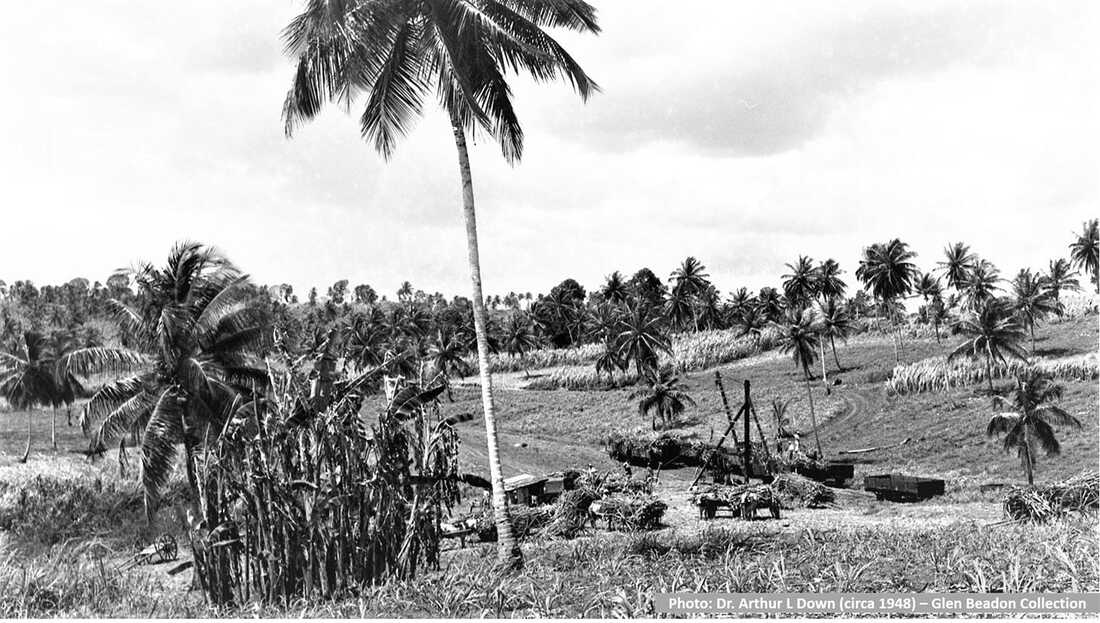 Photo by Dr Arthur Down circa 1947 - Cane at railhead being loaded upon rail cars for onward haulage to factory. Note the early timber rail wagons and old-style derrick complete with mule-power winching apparatus. Cane fields, coconut and banana trees flourish together under the tropical sunshine. A collection of animal drawn carts, awaiting their turn for loading up. A period picture that remained unchanged for almost 150 years across the Naparimas of South Trinidad. HISTORY So many factors in history are linked. A very good example of this in Trinidad is Cane Farming and the railways that served the practice. Few people today understand the role played by private cane farmers and the rich history associated with it. It is recorded that Cane Farming in Trinidad was started in 1882 by Sir Neville Lubbock, who was the Managing Director of the Colonial Company (at Usine Ste Madeleine 1870 - 1895). The idea of creating cane farmers was born out of the need to increase grinding capacity without having to increase company personnel. The advent of railways across Trinidad allowed cut canes to be transported from any part of the island to the central factories. Cane farmers would benefit from selling their produce without the need for capital investment and the cost of building and running a factory. In 1896 some of the leading planters were willing to receive immigrant farmers and their families and to allot to each half of an acre of land free of rent as a garden, to be planted as the immigrant pleased. In addition to this a certain amount of cane land was appointed to each immigrant upon which he was required to plant canes. Once cane was ripe and ready for harvesting, this cane would be purchased by the planters at a rate of nine shillings per ton, if delivered to the mill. If, however, the estate was required to cut load and cart the cane to factory, then the rate would be six shillings per ton. As time went on cane farmers increased their acreage across their own private lands and with the expansion of railways the business became much more worthwhile due to increased volume, but it did of course suffer during periods of world market volatility. The cane farmers across Trinidad became an important partner in the sugar industry and a stabilizing force in the country. Their reliance on the railway was apparent right up until 1998 when the railway between Barrackpore and Ste Madeleine was closed. To provide some idea of this association between farmers and the railway, in 1955 the Trinidad Government Railway (TGR) carried 200,000 tons of cane to factory which was about 11% of a total of 1,800,000 tonnes of canes milled that year. At that time, sugar canes were carried at rates far below cost, under what was regarded as a Government subsidy to the sugar industry. This low rate was specifically designed to help private cane farmers to get their produce to the factories. In 1956 the ‘Cane Farmers Association’ was founded and it became a highly effective mouthpiece in dealing with Government and the sugar Manufacturers. In 1963 alone there were some 11,000 cane farmers in Trinidad, and at the time they produce about 35% of the ground cane, a very respectable contribution. If we look at the 1969 figures for cane transported by rail across Trinidad it is clear to appreciate the relation between farmers and their reliance on rail transport. Out of 695,300 tons of canes transported by rail that year a total of 394,800 tons was farmers cane. The total transported by road shows that rail was, at that time, in the process of being ‘phased out’ with 1,048,400 tons carried by tasker trucks. Out of this total, only 153,000 tons was farmers cane. After the TGR folded in 1968, it was Caroni (1975) Limited which carried on the Trinidad railway tradition for a further 30 years. At first both the Northern Division at Brechin Castle and Southern Division at Usine Sainte Madeleine would continue with their rail transport divisions. The northern division was the first to go at the end of the 1976 season, but Usine Ste. Madeleine continued running trains until 1998. Extraction of high-quality farmers’ cane from the valley line in Barrackpore was instrumental in retaining this railway for as long as it did. The sugar industry in Trinidad folded five years later in 2003. We should never forget the contribution and extremely hard work made by Cane Farmers to an industry that was once a thriving concern across Trinidad and Tobago. Source: Glen Beadon 10 December 2019, Virtual Museum of TT
0 Comments
Leave a Reply. |
T&T news blogThe intent of this blog is to bring some news from home and other fun items. If you enjoy what you read, please leave us a comment.. Archives
July 2025
Categories
All
|

 RSS Feed
RSS Feed